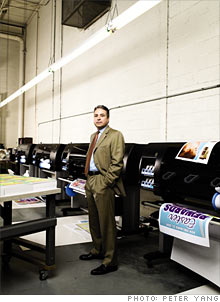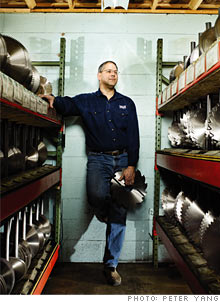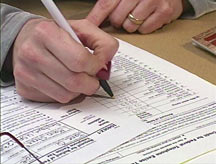2009: Keep more cash!
Key strategies for maximizing your deductions and holding on to the cash your business needs.
 |
| Foxfire Printing founder John Ferretti is using this year's operating loss to cut his tax bill. |
 |
| Peerless Saw CEO Tim Gase used this year's tax breaks to invest in new equipment. |
(Fortune Small Business) -- When your accountant prepares your business tax, you may feel a bit like Bill Murray's character in Groundhog Day, only this time forced to relive the indignities of 2008 again and again. Yes, last year was a bummer for many American entrepreneurs. But like Murray's cynical weatherman, you have an opportunity to improve upon the past.
With smart tax moves, you may be able to recover some of the money you lost in a bruising 2008. Fortune Small Business talked with a dozen tax experts, who identified such savvy strategies as carrying a loss back to previous years, accelerating write-offs for equipment purchases and claiming deductions for unsold inventory. We also found small business owners who have effectively used each strategy to preserve much-needed cash rather than forking it over to the feds.
Foxfire Printing had a rough 2008. Based in Newark, Del., Foxfire creates in-store signage for clients such as Pep Boys and Supervalu. Last year many of its other retail customers closed stores and slashed marketing budgets - one valued client even went bankrupt. As a result, Foxfire's revenues fell from $25 million in 2007 to $23 million in 2008, and the company posted its first loss since 2000.
But founder John Ferretti plans to recoup some of that money by executing what's called a net operating loss (NOL) carryback. "Bankers aren't lending," he says. "So I'm grateful there's a piece of the tax code that will put some capital into my business."
Here's how the carryback works. Say you lost $1 million in 2008 after turning a $500,000 profit in each of the previous two years. You carry the loss backward by having your accountant amend your 2007 tax return to offset the entire profit for that year. You would then be due a refund on any federal taxes you paid on that profit - and state taxes in roughly a third of the states. You would still show a loss balance of $500,000, which you could carry back to 2006 and offset your profit for that year as well.
Generally you can carry a loss back for only two years. (In light of last year's red ink tsunami, the economic recovery bill President Obama signed Tuesday extended the carryback to five years for businesses with gross receipts of $15 million or less.) Some companies may still have a loss balance even after amending two years' worth of tax returns. Luckily, you can also carry a NOL forward to offset profits for up to 20 years.
Be aware that the IRS can take up to a year to refund money from a NOL carryback. But there's an expedited form (IRS 1139) that will get cash into your hands twice as fast, though it can be used only by businesses that are organized as C corporations.
Ordinarily you would depreciate purchases of, for example, equipment and machinery, both of which are treated in IRS form 946. The list is broad and allows plenty of wiggle room - it includes everything from drill presses and desk chairs to landscaping shrubs. The IRS sets depreciation schedules for these sundry items, typically ranging from three to 15 years.
Depreciation helps you recoup your money, but often in small increments over more than a decade. There's also a cunning and perfectly legal strategy that you can use to take a large write-off in a single year; it's called a Section 179 deduction.
"The name is dull," says Blake Christian, a C.P.A. with Holthouse Carlin & Van Trigt in Long Beach, Calif. "But Section 179 can really supercharge your deductions."
Taking a large one-time deduction makes sense, especially in the current economy. You get a bigger chunk of change to plow back into your business right now. And you won't lose ground to inflation, which happens when you depreciate a purchase over many years.
Peerless Saw manufactures round steel blades that are used by such companies as International Paper and Pella, the windowmaker. Based in Groveport, Ohio, Peerless is coming off one of its worst years since the company was founded in 1931. Revenues dropped to $9 million in 2008 from $9.5 million in 2007. Profits plunged as well.
During this challenging year, CEO Tim Gase chose to keep his firm competitive by buying new equipment. Among his purchases were two state-of-the-art grinders capable of crafting steel to tolerances of less than a thousandth of an inch. The total tab: $150,000.
Gase could have opted to depreciate the machinery over seven years in accordance with the IRS's schedule. Instead, thanks to Section 179, Peerless was able to write off the entire $150,000 in 2008. This will lower its tax bite, providing fast cash to the struggling firm.
"Why wouldn't you take the whole thing now if you need it?" asks Gase, adding, "We need it."
Section 179 is truly a small business tax break. It cannot be used by companies whose equipment purchases total more than $1,050,000 in a given year. (Businesses that have posted a net loss are also disqualified.) For 2008, firms can write off a generous amount under this section. Last winter, as part of an emergency economic stimulus package, Congress raised the limit from $128,000 to $250,000. The new economic recovery bill extends that higher limit through 2009.
Another write-off accelerator, bonus depreciation, was also created as part of last year's emergency stimulus package and extended through 2009 in this year's stimulus bill. Bonus depreciation allows you to write off half the cost of a piece of equipment during the first year. Say you spent $5,000 on a computer, an item that depreciates over five years. Under bonus depreciation, you could write off $2,500 in the first year and depreciate the balance over four years.
It's even possible to combine Section 179 with bonus depreciation. For example, if you bought $800,000 worth of equipment, you could write off the first $250,000 this year, maxing out your Section 179 deduction. For the remaining $550,000, you could use bonus depreciation to immediately write off half ($275,000). The balance would be depreciated over multiple years according to the usual schedule.
-
The Cheesecake Factory created smaller portions to survive the downturn. Play
-
A breeder of award-winning marijuana seeds is following the money and heading to the U.S. More
-
Most small businesses die within five years, but Amish businesses have a survival rate north of 90%. More
-
The 10 most popular franchise brands over the past decade -- and their failure rates. More
-
These firms are the last left in America making iconic products now in their twilight. More













